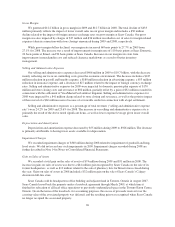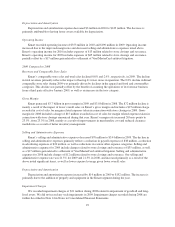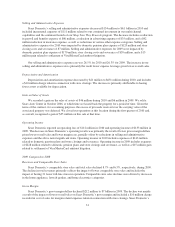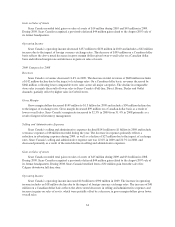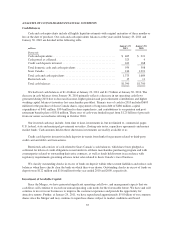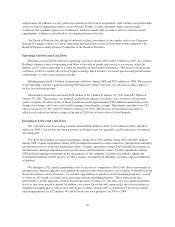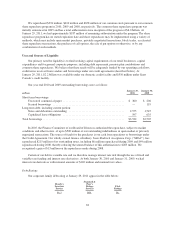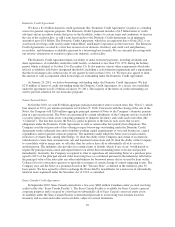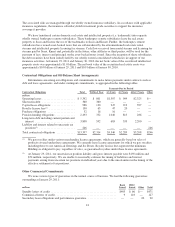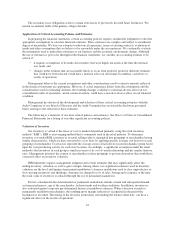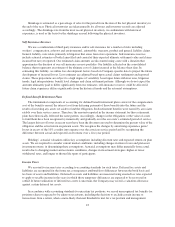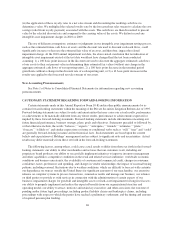Sears 2010 Annual Report Download - page 36
Download and view the complete annual report
Please find page 36 of the 2010 Sears annual report below. You can navigate through the pages in the report by either clicking on the pages listed below, or by using the keyword search tool below to find specific information within the annual report.authorization. In addition, we may pursue investments in the form of acquisitions, joint ventures and partnerships
where we believe appropriate returns can be obtained. Further, we may determine under certain market
conditions that available capital is best utilized to fund investments that we believe offer us attractive return
opportunities, whether or not related to our ongoing business activities.
Our Board of Directors has delegated authority to direct investment of our surplus cash to our Chairman,
Edward S. Lampert, subject to various limitations that have been or may be from time to time adopted by the
Board of Directors and/or Finance Committee of the Board of Directors.
Operating Activities and Cash Flows
Holdings generated $130 million in operating cash flows during 2010 and $1.5 billion in 2009. As a retailer,
Holdings’ primary source of operating cash flows is the sales of goods and services to customers, while the
primary use of cash in operations is to fund the purchase of merchandise inventories. The decrease in operating
cash flows in 2010 is mainly the result of higher working capital balances, increased pension and postretirement
contributions, as well as decreased net income.
Holdings generated $1.5 billion in operating cash flows during 2009 and $992 million in 2008. The increase
in net operating cash flows generated during 2009 primarily reflects increases in cash from working capital, as
well as increased net income.
Merchandise inventories increased $418 million to $9.1 billion at January 29, 2011 from $8.7 billion at
January 30, 2010. The increase was primarily in the Kmart apparel, electronics, toys, footwear and sporting
goods categories. Inventory levels at Sears Canada increased approximately $150 million primarily due to the
change in exchange rates, lower sales and the timing of merchandise receipts. Merchandise payables were $3.1
billion at January 29, 2011 and $3.3 billion at January 30, 2010. The decrease in merchandise payables is
reflective of reduced inventory receipts at the end of 2010 due to lower sales at Sears Domestic.
Investing Activities and Cash Flows
Net cash flows used in investing activities totaled $406 million in 2010, $172 million in 2009, and $637
million in 2008. Cash used in investing activities in all three years was primarily used for purchases of property
and equipment.
We spent $441 million on capital expenditures during 2010, $361 million during 2009 and $497 million
during 2008. Capital expenditures during 2010 included investments in online initiatives, information technology
and infrastructure for stores and distribution centers. Capital expenditures during 2009 included investments in
information technology and infrastructure for the stores and distribution centers. Capital expenditures during
2008 included ongoing investments in the maintenance of the company’s facilities (including a significant
investment in lighting retrofit projects to reduce energy consumption in Holdings’ facilities) and in information
technology.
We anticipate 2011 capital expenditure levels to increase as compared to 2010 levels, due to investment in
information technology upgrades and ongoing investment in the infrastructure of our facilities. It should be noted
that in the normal course of business, we consider opportunities to purchase leased operating properties, as well
as offers to sell owned, or assign leased, operating and non-operating properties. These transactions may,
individually or in the aggregate, result in material proceeds or outlays of cash and cause our capital expenditure
levels to vary from period to period. In addition, we review leases that will expire in the short term in order to
determine the appropriate action to take with respect to them. During 2008, we purchased 9 previously leased
operating properties for $22 million. We did not make any such purchases in 2010 or 2009.
36


